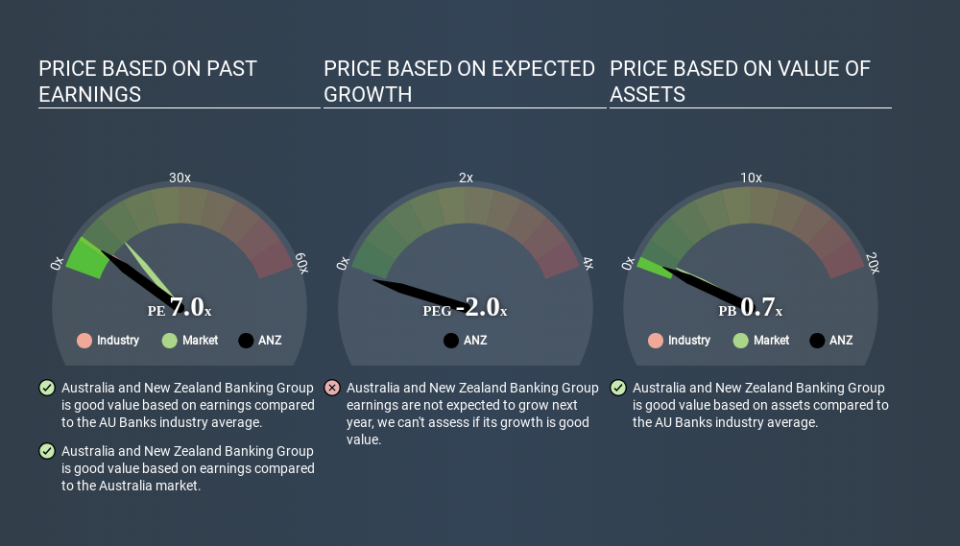How Does Australia and New Zealand Banking Group's (ASX:ANZ) P/E Compare To Its Industry, After The Share Price Drop?

Unfortunately for some shareholders, the Australia and New Zealand Banking Group (ASX:ANZ) share price has dived 41% in the last thirty days. That drop has capped off a tough year for shareholders, with the share price down 41% in that time.
Assuming nothing else has changed, a lower share price makes a stock more attractive to potential buyers. In the long term, share prices tend to follow earnings per share, but in the short term prices bounce around in response to short term factors (which are not always obvious). So, on certain occasions, long term focussed investors try to take advantage of pessimistic expectations to buy shares at a better price. One way to gauge market expectations of a stock is to look at its Price to Earnings Ratio (PE Ratio). A high P/E ratio means that investors have a high expectation about future growth, while a low P/E ratio means they have low expectations about future growth.
Check out our latest analysis for Australia and New Zealand Banking Group
How Does Australia and New Zealand Banking Group's P/E Ratio Compare To Its Peers?
We can tell from its P/E ratio of 6.97 that sentiment around Australia and New Zealand Banking Group isn't particularly high. The image below shows that Australia and New Zealand Banking Group has a lower P/E than the average (7.8) P/E for companies in the banks industry.
This suggests that market participants think Australia and New Zealand Banking Group will underperform other companies in its industry. Since the market seems unimpressed with Australia and New Zealand Banking Group, it's quite possible it could surprise on the upside. You should delve deeper. I like to check if company insiders have been buying or selling.
How Growth Rates Impact P/E Ratios
Earnings growth rates have a big influence on P/E ratios. Earnings growth means that in the future the 'E' will be higher. Therefore, even if you pay a high multiple of earnings now, that multiple will become lower in the future. A lower P/E should indicate the stock is cheap relative to others -- and that may attract buyers.
Australia and New Zealand Banking Group shrunk earnings per share by 9.6% last year. But over the longer term (3 years), earnings per share have increased by 4.0%. And EPS is down 3.6% a year, over the last 5 years. So we might expect a relatively low P/E.
A Limitation: P/E Ratios Ignore Debt and Cash In The Bank
The 'Price' in P/E reflects the market capitalization of the company. In other words, it does not consider any debt or cash that the company may have on the balance sheet. Theoretically, a business can improve its earnings (and produce a lower P/E in the future) by investing in growth. That means taking on debt (or spending its cash).
Such spending might be good or bad, overall, but the key point here is that you need to look at debt to understand the P/E ratio in context.
How Does Australia and New Zealand Banking Group's Debt Impact Its P/E Ratio?
Net debt is 36% of Australia and New Zealand Banking Group's market cap. While it's worth keeping this in mind, it isn't a worry.
The Verdict On Australia and New Zealand Banking Group's P/E Ratio
Australia and New Zealand Banking Group has a P/E of 7.0. That's below the average in the AU market, which is 13.0. Since it only carries a modest debt load, it's likely the low expectations implied by the P/E ratio arise from the lack of recent earnings growth. Given Australia and New Zealand Banking Group's P/E ratio has declined from 11.7 to 7.0 in the last month, we know for sure that the market is more worried about the business today, than it was back then. For those who prefer to invest with the flow of momentum, that might be a bad sign, but for deep value investors this stock might justify some research.
Investors should be looking to buy stocks that the market is wrong about. If the reality for a company is not as bad as the P/E ratio indicates, then the share price should increase as the market realizes this. So this free visualization of the analyst consensus on future earnings could help you make the right decision about whether to buy, sell, or hold.
Of course you might be able to find a better stock than Australia and New Zealand Banking Group. So you may wish to see this free collection of other companies that have grown earnings strongly.
If you spot an error that warrants correction, please contact the editor at editorial-team@simplywallst.com. This article by Simply Wall St is general in nature. It does not constitute a recommendation to buy or sell any stock, and does not take account of your objectives, or your financial situation. Simply Wall St has no position in the stocks mentioned.
We aim to bring you long-term focused research analysis driven by fundamental data. Note that our analysis may not factor in the latest price-sensitive company announcements or qualitative material. Thank you for reading.


